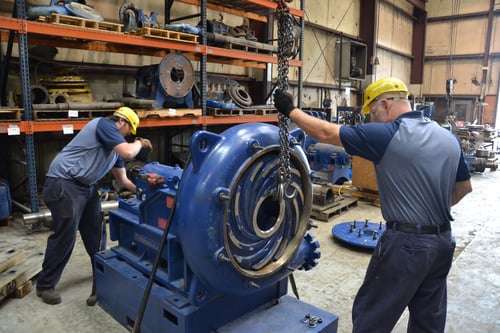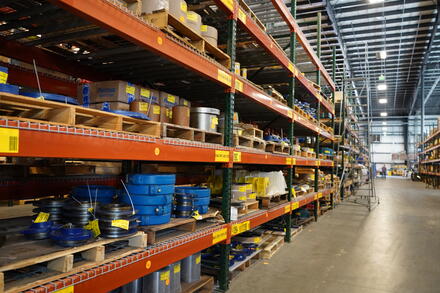.jpg?width=681&height=511&name=3%20Pumps%20in%20Hyd%20Lab%2020171004%20(7).jpg)
Are you looking for a pump supplier that can deliver the “complete package”? Or perhaps, you need an industry expert that can help you optimize your current operations. KSB stands ready to provide you the best information, service, and slurry pump solutions. Here’s a look at what you need to know to start your year strong.
1. The Complete Pump Package Supplier
KSB Mining is a one-stop pump shop, dedicated to serving our customers all over the world. We have 37 production sites in 18 countries and nine foundries on three continents. Plus, we have over 3500 worldwide service staff ready to assist you wherever you may be. KSB Mining has proven it is well equipped to offer our partners a complete package of products and service.

Four reasons to choose KSB Group as your pump supplier.
1. You benefit from over 150 years of expertise in slurry transport.
The KSB Group is renowned for its customer service. KSB has 150 years of experience in water pumps, valves, and service. KSB GIW, Inc. has 130 years of experience in slurry pumps and slurry transport. Invest in a name you can trust.
2. You can be confident the pump you get is the right one for the job.
Choosing the right pumps for specific slurries helps pump owners avoid unnecessary maintenance, repairs, and related downtime. Proper pump applications make for safer work environments, and purpose-chosen slurry pumps have longer wear lives. Our proprietary pump selection program, GIW® SLYSEL and KSB Select, helps pump owners meet their exact specifications. SLYSEL also helps pump operators ensure proper operation, reducing room for error and maintaining pump longevity.
3. You can count on continuous availability of spare parts.
Original equipment manufacturer (OEM) parts are critical. Pressure to minimize operating costs makes non-OEM spare parts tempting as a shortcut with a positive bottom-line impact. But the upfront cost-savings will be mitigated by parts that cause more harm than good. KSB’s dedicated tech service team provides forecast and inventory support, so you have the OEM spare parts you need when you need them.
4. Your success is our #1 goal.
From order to delivery and assembly, KSB has a clear mission: We use our expertise to make our customers’ experience easy and successful. We provide exceptional and unparalleled customer service. Our Project Management team ensures customers meet their financial goals and helps KSB guarantee timeline milestones for all deliverables.
2. How Does KSB Analyze Customer Pumping Problems?
Few spaces in the slurry pumping industry are as innovative and well-known as the KSB GIW Hydraulic Lab. This large-scale testing facility is equipped for testing pump performance and optimizing slurry systems. Its sole purpose is to assist customers as they seek ways to improve all areas of their slurry transport applications.
.jpg?width=500&name=3%20Pumps%20in%20Hyd%20Lab%2020171004%20(7).jpg)
The Hydraulic Lab serves as a testing and training facility for all things slurry related. These include:
- Full-size pump testing. Measuring and validating the hydraulic and mechanical performance of pumps.
- Contract slurry testing. Running customer specific slurry types through our piping systems (ranging from 75 to 500 millimeters in diameter) to help optimize, quantify, and validate slurry equipment performance for unique applications.
- In-depth materials testing. Determining erosive and corrosive wear to develop new materials and parts.
- Training for supervisors and maintenance personnel. Educating those responsible for centrifugal slurry pump operation and upkeep.
Without this facility, engineers and other pump personnel would have to travel the world to find the various environments, applications, and slurry systems necessary for analyzing their slurry transport needs in context.
In this controlled environment, convenience and testing capabilities are unmatched. From determining pipeline friction and solids deposition to maximizing part wear life and optimizing pump performance, the Hydraulic Lab exists to help KSB Mining customers improve their slurry transport systems and lower their total cost of ownership.
Seeing beyond our own bottom line is what sets us apart. We want to make a difference in our customers’ pumping capabilities and solidify our relationship with them as a long-term pump provider and service partner. The Hydraulic Lab makes that relationship possible. Our customers and industry peers trust us to solve their real-world pumping problems, and we take that responsibility seriously.
3. Ongoing Pump Support
Four things to do right now to ensure you have the proper pump support.
1. Take advantage of digital tech support options.
Technicians are often limited in their ability to visit customers on-site, but virtual technologies are highly effective for diagnosing field issues. Zoom meetings, screen sharing, and video conferencing are all ways KSB provides support for customers seeking to limit onsite visits. It’s one way KSB ensures your service will not be interrupted.
Plan ahead for further disruption with KSB Group’s free online training courses in centrifugal pumps, hydraulics, and materials.
2. Follow the 3-2-1 rule for spare parts
The 3-2-1 rule means customers should stock 3 liners and 2 impellers for every 1 casing. This will prepare you for the unexpected and give you breathing room should your supply chains become problematic again.
Typically, we advise our customers to keep several spare parts handy. This includes impellers, gaskets/seals, shaft sleeves, shells, TUF-PAK packing, and suction liners. When stocking up under the 3-2-1 rule, be sure to stock OEM spare parts. Replicator parts typically do not conform to the required tolerance.

3. Keep up with your maintenance plan.
Slurry pumps, like all heavy equipment, require periodic TLC to function properly. Without maintenance, pumps can suffer catastrophic failures that lead to downtime and possible injury. Critical pump maintenance tasks include:
- Daily: Check oil, monitor gauges, watch for leaks, verify V-belt tension.
- Weekly: Record gauge readings. Readjust the impeller, as necessary.
- Quarterly: Empty and replace lubricant and replace, clean and oil studs and threads, inspect the stuffing box.
- Semiannual: Full pump inspection, inspect and flush drains, clean bearings and housings.
Keeping up with maintenance could extend the life of your pump and ensure it has the right support long after the pandemic is over.
4. Know who to call in a crisis.
Failing to plan is planning to fail, and pump failures can cost you big money. Knowing who to call during a crisis isn’t something you want to try to figure out mid-crisis. Make a breakdown plan to cope with the unthinkable, just in case.
